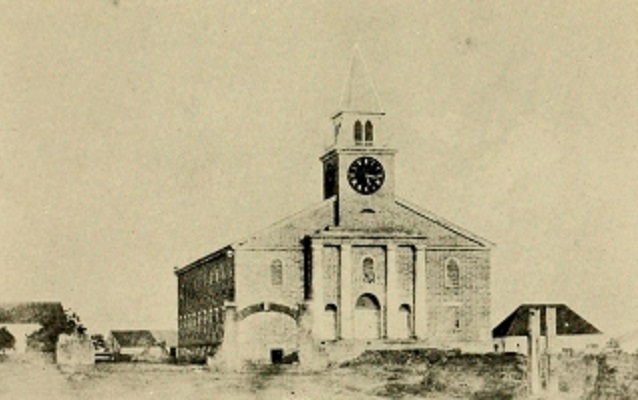Last updated: August 15, 2019
Place
Kawaiaha'o Church and Mission Houses

The earliest known photo of Kawaiaha'o Church. The Mission Houses are in the background, c. 1857
Kawaiaha'o Church, in Honolulu on the Island of Oahu, is often referred to variously as the Westminster Abbey of Hawaii and the Protestant Mother Church of Hawaii. The three neighboring Mission Houses served as the most important force in Hawaiian politics, religion, economics, and social customs from 1820 to 1860. Kawaiaha'o Church, the Mission Houses, and the adobe schoolhouse on the grounds collectively symbolize the influence of the missionaries in the Kingdom of Hawai'i.
In 1819, the American Board of Commissioners for Foreign Missions, a Protestant organization supported by the Congregational, Presbyterian, and several other churches, agreed to expand their work to the Hawaiian Islands. A missionary party landed in Honolulu on April 19, 1820 and was quickly accepted by the Hawaiian ali'i (chiefs). King Kamehameha II assigned the missionaries land near a spring known as Kawaiaha'o and directed Hawaiian laborers to build them thatched houses in which to live. The missionaries resided in the houses and used one room as a meeting place for school during the week. Within four decades of its founding, the school had helped to raise the literacy rate on the island to 80 percent.
In 1821, the growing congregation in Honolulu constructed a thatched-roof wooden church a short distance toward the sea from the site of the present church. This church burned down in 1824, but Chief Kalanimoku, the Prime Minister of the Hawaiian Islands, ordered another erected near the original. In 1825, the first public ceremony of Thanksgiving took place in this chapel. A storm demolished a temporary chapel built in 1825, to accommodate large crowds. A third meetinghouse was erected in 1827, and a fourth in 1829.
Kawaiaha'o Church, in Honolulu on the Island of Oahu, is often referred to variously as the Westminster Abbey of Hawaii and the Protestant Mother Church of Hawaii. The three neighboring Mission Houses served as the most important force in Hawaiian politics, religion, economics, and social customs from 1820 to 1860. Kawaiaha'o Church, the Mission Houses, and the adobe schoolhouse on the grounds collectively symbolize the influence of the missionaries in the Kingdom of Hawai'i.
In 1819, the American Board of Commissioners for Foreign Missions, a Protestant organization supported by the Congregational, Presbyterian, and several other churches, agreed to expand their work to the Hawaiian Islands. A missionary party landed in Honolulu on April 19, 1820 and was quickly accepted by the Hawaiian ali'i (chiefs). King Kamehameha II assigned the missionaries land near a spring known as Kawaiaha'o and directed Hawaiian laborers to build them thatched houses in which to live. The missionaries resided in the houses and used one room as a meeting place for school during the week. Within four decades of its founding, the school had helped to raise the literacy rate on the island to 80 percent.
In 1821, the growing congregation in Honolulu constructed a thatched-roof wooden church a short distance toward the sea from the site of the present church. This church burned down in 1824, but Chief Kalanimoku, the Prime Minister of the Hawaiian Islands, ordered another erected near the original. In 1825, the first public ceremony of Thanksgiving took place in this chapel. A storm demolished a temporary chapel built in 1825, to accommodate large crowds. A third meetinghouse was erected in 1827, and a fourth in 1829.
David Chamberlain began building the First Printing House in December of 1822. The missionaries needed a means of printing and brought a second-hand press with them to the island. Completed in December of 1823, the shop, standing at just 28 by 17 feet, is thought to be the first printing house west of the Rocky Mountains. By 1828, due to increased volume and demand, the press moved to a larger space across the street. The First Printing House is the oldest surviving building associated with the Hawaiian Mission press. Today the house serves as a museum; a replica of the first printing press and its print work are on display in the building along with other items from the early mission period.
The Chamberlain House got its name from Levi Chamberlain, who came to Honolulu in 1823 to store food, clothing, furniture, and other supplies needed by the various island mission stations and to distribute supplies as needed. In 1830, Chamberlain started to build a two-story, coral-stone building with a cellar and attic, similar to houses of the same period in New England. The house had a design that suited it to the New England climate, not Hawaii. Upon completion of the building in December of 1831, Chamberlain's family moved into three rooms on the lower level. In 1910, the Mission Children's Society acquired ownership of the house.
Today, Kawaiaha'o Church is still an active place of worship and the Mission Houses, located across the street, are part of the Hawaiian Mission Houses Historic Site and Archives. Both sites are open to the public.
